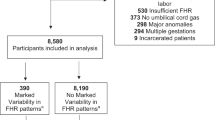Abstract
Objective
In this study, we tried to establish cut-off values for more than one parameters of computerized cardiotocography (c CTG) in the prediction of fetal distress during labor, using a group of pregnant women with low-risk pregnancies.
Method
A retrospective study was performed. Data were collected from 167 patients for measurements of fetal heart rate (FHR) variables and perinatal outcome. Computerized CTG was performed with an Oxford Sonicaid monitor with connection to a 8000 system for CTG spontaneous analysis. The following c CTG variables were considered: FHR, number of accelerations, the presence and the number of episodes of high and low variation, the number of decelerations, short-term variation (STV), peaks of contractions (per hour) and fetal movements assessed by maternal perception (per hour). Computerized CTG recordings started not earlier than the beginning of week 38 of gestation. Immediately after delivery, blood sample was collected from umbilical artery for umbilical artery blood gas analysis (UBGA). The main UBGA parameter in cord umbilical artery that was considered for analysis was pH. pH values <7.25 were considered as suspicious for acidemia and pH values ≥7.25 as normal.
Results
Women suspicious for fetal distress during labor presented significantly lower fetal movements (P = 0.026), accelerations (P = 0.018), variability (P < 0.001), number of high episodes (P < 0.001), higher values of FHR baseline (P < 0.001) and low episodes (P < 0.001). Only the number of decelerations did not differ significantly between the two groups (P = 0.545). The cut-off points of 5.00 for STV and 3.00 for high episodes were determined to classify women with fetal distress, which yielded high sensitivities (34 and 52%) and specificities (96.6 and 94.9%), with positive predictive values of 81.0 and 81.3% and negative predictive values of 77.4 and 82.2%, respectively.
Conclusions
In conclusion, we believe that not only STV but also other components of the cCTG, mainly the presence and the number of episodes of high variation, are related to pregnancy’s outcome as measured by an umbilical artery pH.
Similar content being viewed by others
References
Salamalekis E, Siristatidis C, Vasios G et al (2006) Fetal pulse oximetry and wavelet analysis of the fetal heart rate in the evaluation of abnormal cardiotocography tracings. J Obstet Gynaecol Res 32:135–139. doi:10.1111/j.1447-0756.2006.00377.x
Ferrario M, Signorini M, Magenes G et al (2006) Comparison of entropy-based regularity estimators: application to the Fetal Heart Rate Signal for the identification of fetal distress. IEEE Trans Biomed Eng 53:119–125. doi:10.1109/TBME.2005.859809
Ayres de Campos D, Costa-Santos C, Bernardes J et al (2005) Prediction of neonatal state computer analysis of fetal heart rate tracings: the antepartum arm of the SisPorto multicentre validation study. Eur J Obstet Gynecol Reprod Biol 118:52–60. doi:10.1016/j.ejogrb.2004.04.013
Farmakides G, Weiner Z (1995) Computerized analysis of the fetal heart rate. Clin Obstet Gynecol 38:112–120. doi:10.1097/00003081-199503000-00012
Dawes GS, Moulden M, Redman CW (1996) Improvements in computerized fetal heart rate analysis antepartum. J Perinat Med 24:25–36
Todros T, Preve CU, Plazzotta C, Biolcati M, Lombardo P (1996) Fetal heart rate tracings: observers versus computer assessment. Eur J Obstet Gynecol Reprod Biol 68:83–86. doi:10.1016/0301-2115(96)02487-6
Valensise H, Facchinetti F, Vasapollo B, Giannini F, Monte ID, Arduini D (2006) The computerized fetal heart rate analysis in post-term pregnancy identifies patients at risk for fetal distress in labour. Eur J Obstet Gynecol Reprod Biol 125:185–192. doi:10.1016/j.ejogrb.2005.06.034
Buscicchio G, Giannubilo SR, Bezzeccheri V, Scagnoli C, Rinci A, Tranquilli AL (2006) Computerized analysis of the fetal heart rate in pregnancies complicated by preterm premature rupture of membranes (pPROM). J Matern Fetal Neonatal Med 19:39–42. doi:10.1080/14767050500361505
Boog G (2004) Intrapartum computerized fetal heart rate parameters and metabolic acidosis at birth. Obstet Gynecol 103:1002–1003
Garcia GS, Mariani NC, Araujo JE, Garcia RL, Nardozza LM, Moron AF (2008) Fetal acidemia prediction through short-term variation assessed by antepartum computerized cardiotocography in pregnant women with hypertension syndrome. Arch Gynecol Obstet 278:125–128. doi:10.1007/s00404-007-0537-8
Valensise H, Arduini D, Giannini F, Conforti R, Giacomello F, Romanini C (1997) Role of antepartum computerized fetal heart rate analysis in the prediction of fetal distress during labor. Eur J Obstet Gynecol Reprod Biol 73:129–134. doi:10.1016/S0301-2115(97)02740-1
Weiner Z, Farmakides G, Schulman H, Kellner L, Plancher S, Maulik D (1994) Computerized analysis of fetal heart rate variation in postterm pregnancy: prediction of intrapartum fetal distress and fetal acidosis. Am J Obstet Gynecol 171:1132–1138
Zimmer EZ, Paz Y, Goldstick O, Beloosesky R, Weiner Z (2000) Computerized analysis of fetal heart rate after maternal glucose ingestion in normal pregnancy. Eur J Obstet Gynecol Reprod Biol 93:57–60. doi:10.1016/S0301-2115(00)00255-4
Anceschi MM, Piazze JJ, Vozzi G, Ruozi BA, Figliolini C, Vigna R, Cosmi EV (1999) Antepartum computerized CTG and neonatal acid-base status at birth. Int J Gynaecol Obstet 65:267–272. doi:10.1016/S0020-7292(99)00055-7
Bernardes J, Ayres-de-Campos D, Costa-Pereira A, Pereira-Leite L, Garrido A (1998) Objective computerized fetal heart rate analysis. Int J Gynaecol Obstet 62:141–147. doi:10.1016/S0020-7292(98)00079-4
Guzman ER, Vintzileos AM, Martins M, Benito C, Houlihan C, Hanley M (1996) The efficacy of individual computer heart rate indices in detecting acidemia at birth in growth-restricted fetuses. Obstet Gynecol 87:969–974. doi:10.1016/0029-7844(96)00020-8
Nielsen PV, Stigsby B, Nickelsen C, Nim J (1987) Intra- and inter-observer variability in the assessment of intrapartum cardiotocograms. Acta Obstet Gynecol Scand 66:421–424. doi:10.3109/00016348709022046
Chung DY, Sim YB, Park KT, Yi SH, Shin JC, Kim SP (2001) Spectral analysis of fetal heart rate variability as a predictor of intrapartum fetal distress. Int J Gynaecol Obstet 73:109–116. doi:10.1016/S0020-7292(01)00348-4
Conflict of interest statement
None.
Author information
Authors and Affiliations
Corresponding author
Rights and permissions
About this article
Cite this article
Galazios, G., Tripsianis, G., Tsikouras, P. et al. Fetal distress evaluation using and analyzing the variables of antepartum computerized cardiotocography. Arch Gynecol Obstet 281, 229–233 (2010). https://doi.org/10.1007/s00404-009-1119-8
Received:
Accepted:
Published:
Issue Date:
DOI: https://doi.org/10.1007/s00404-009-1119-8




